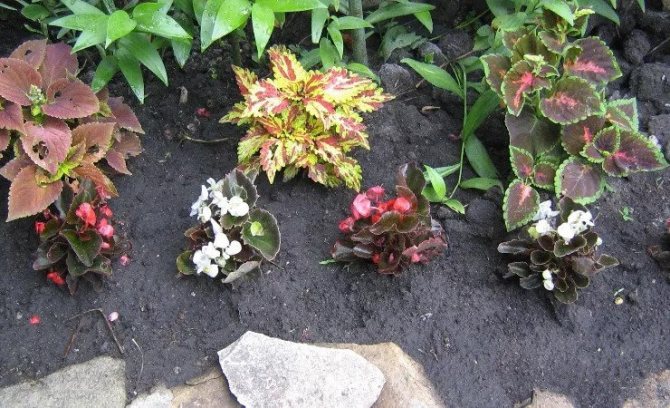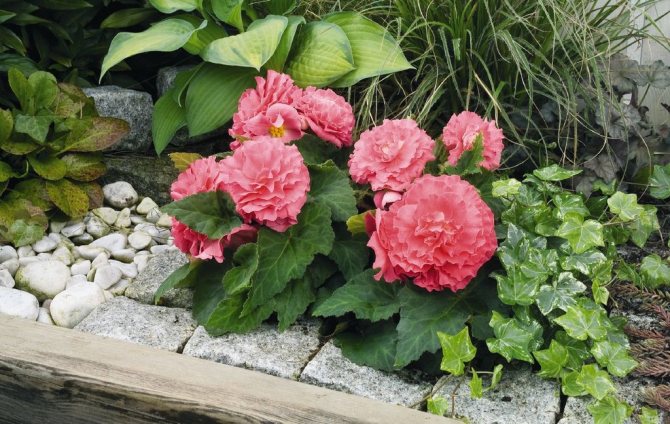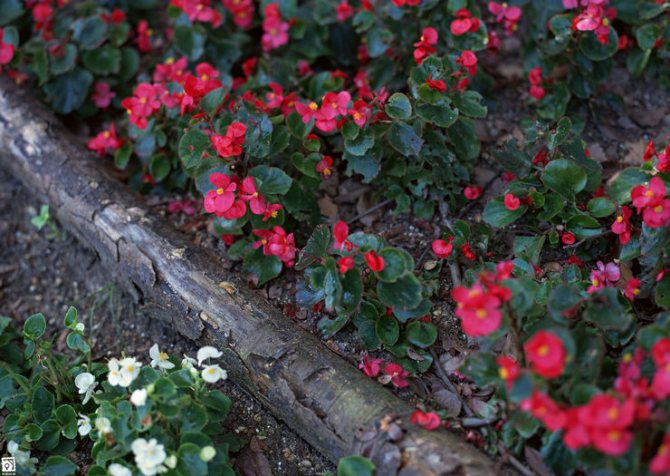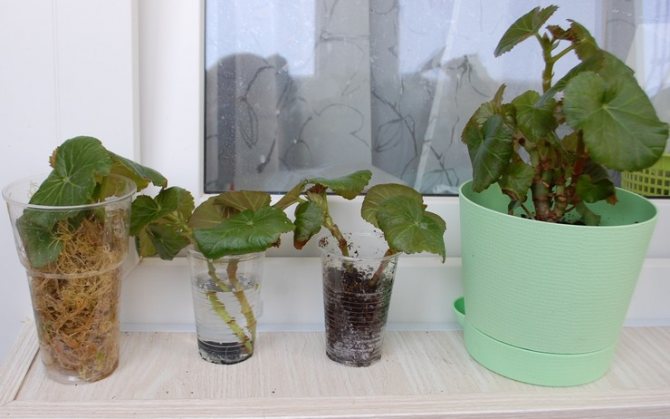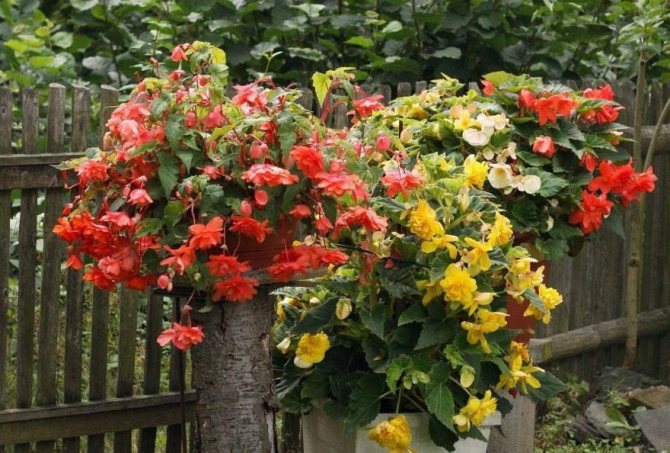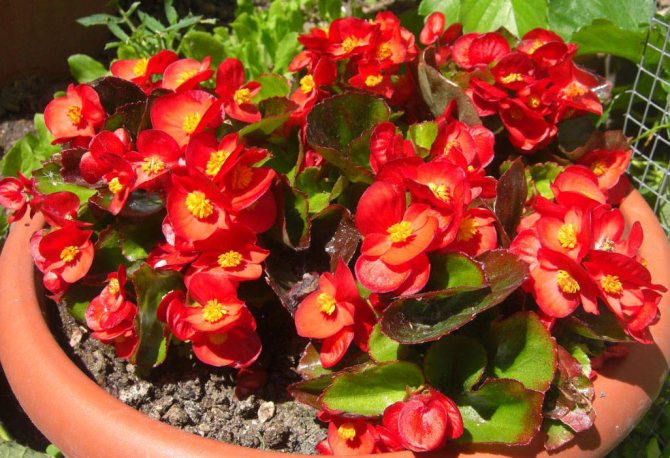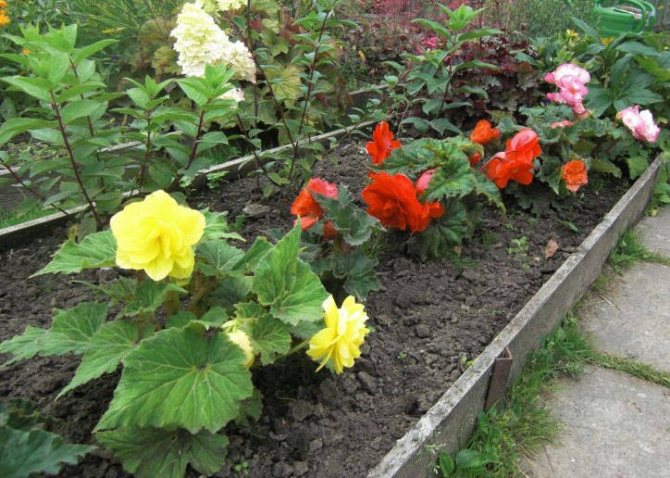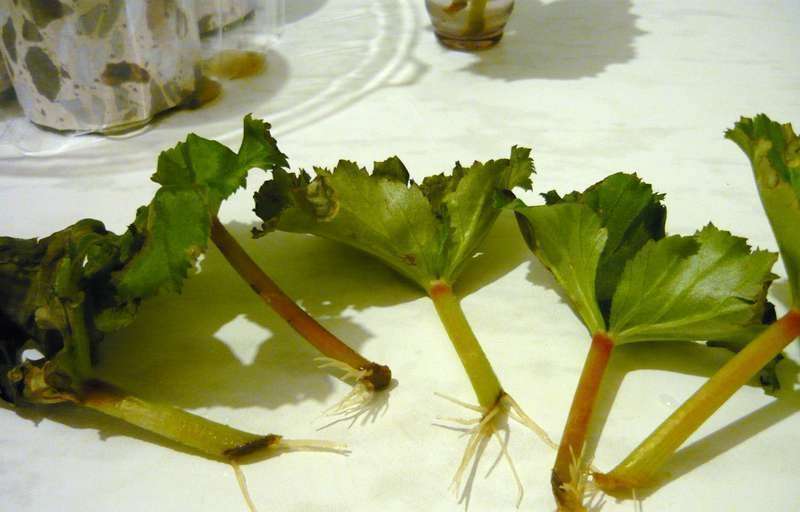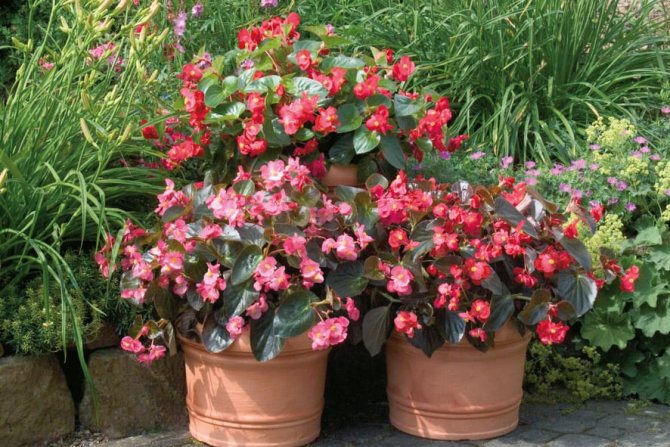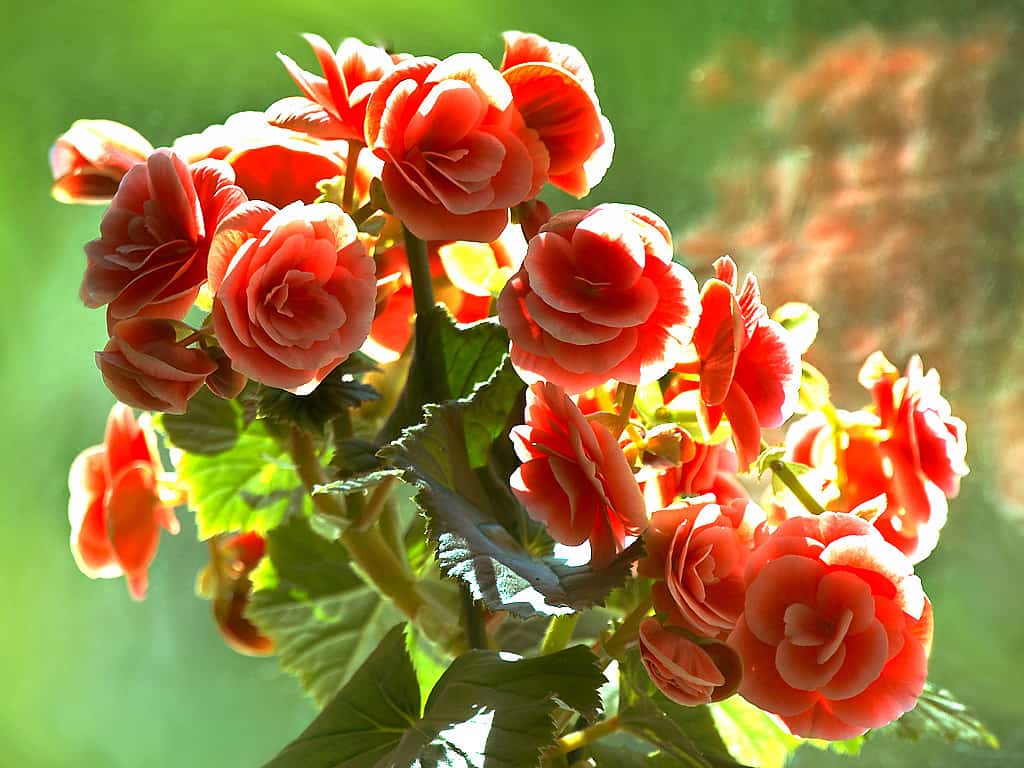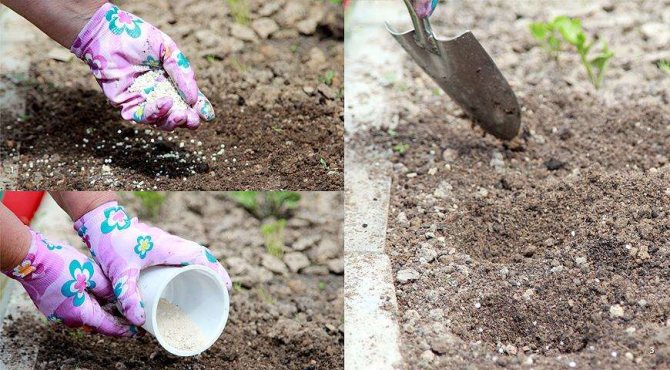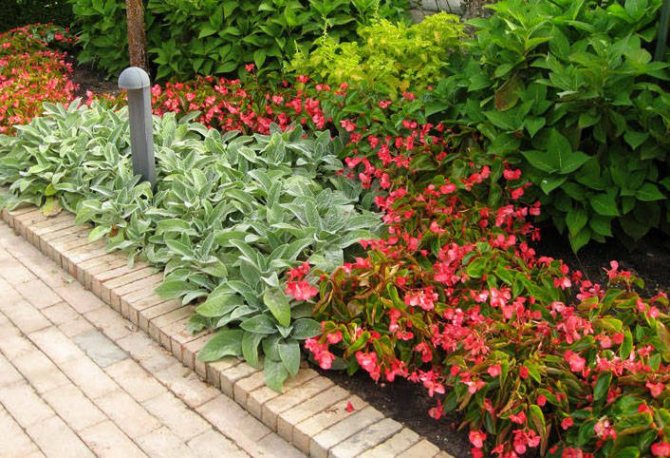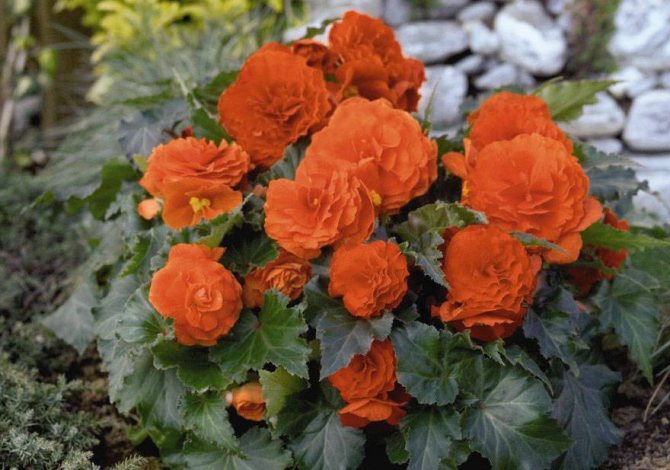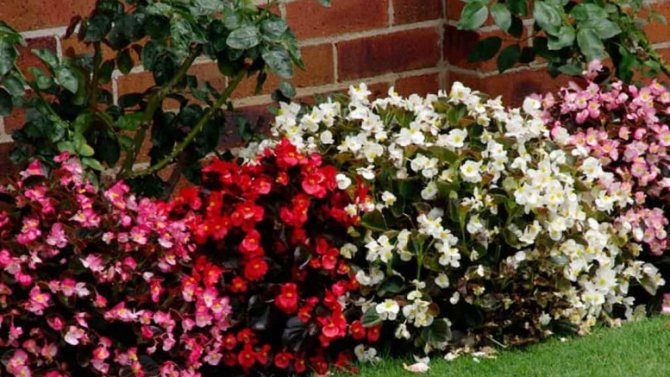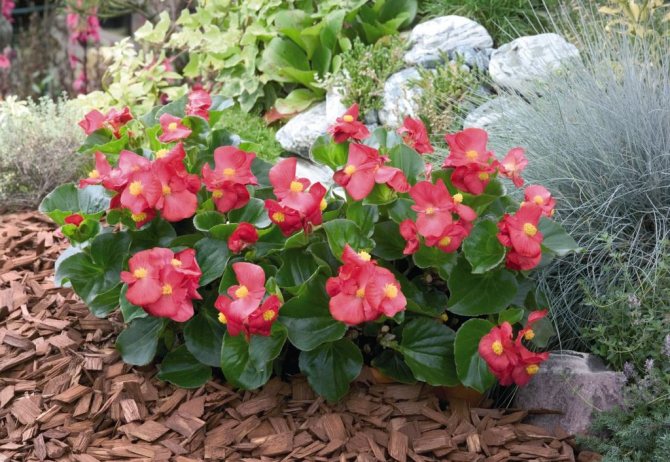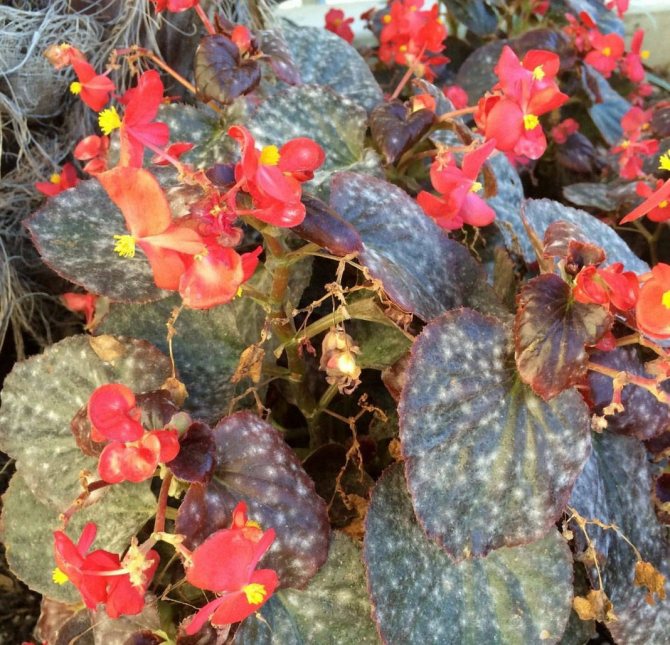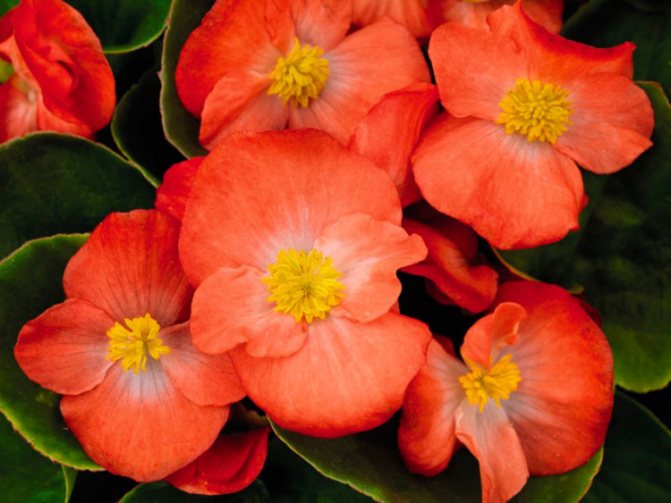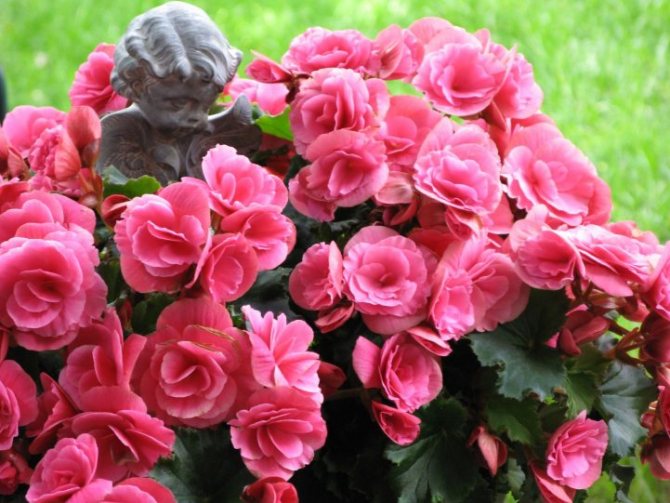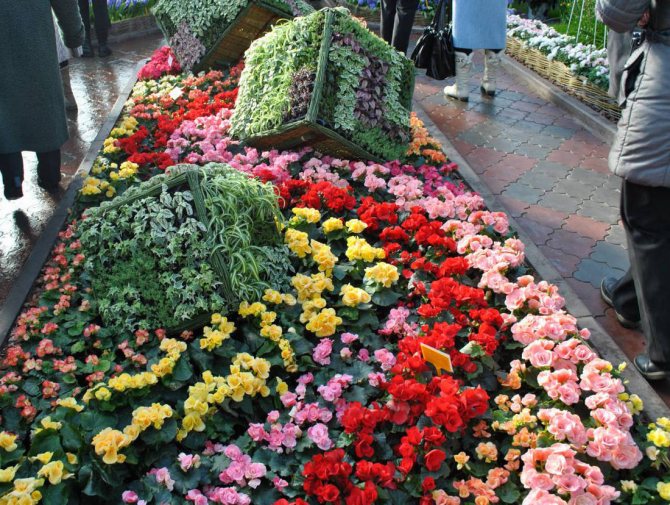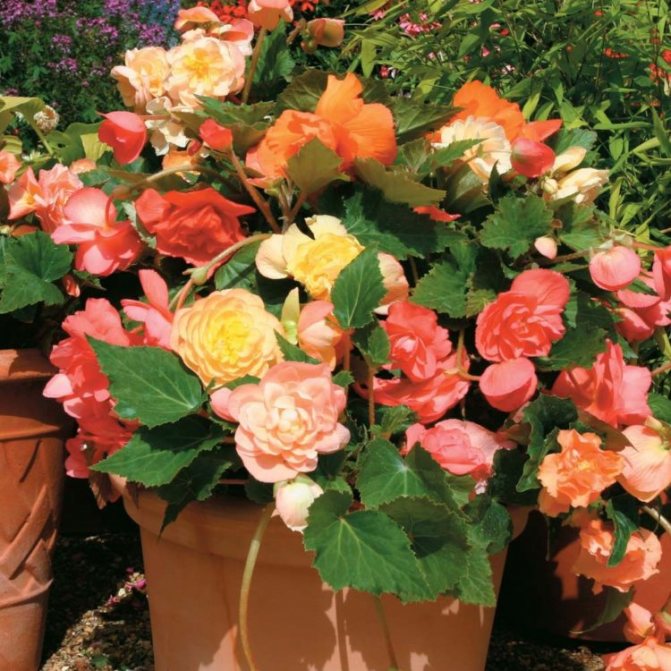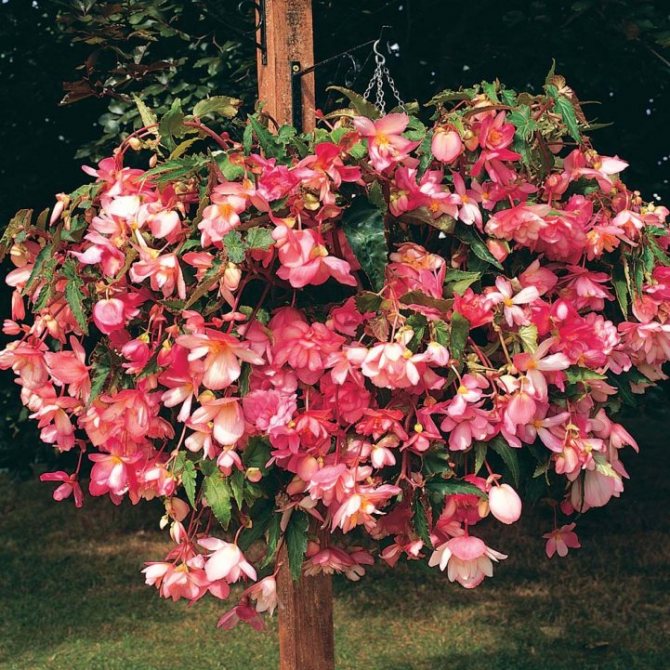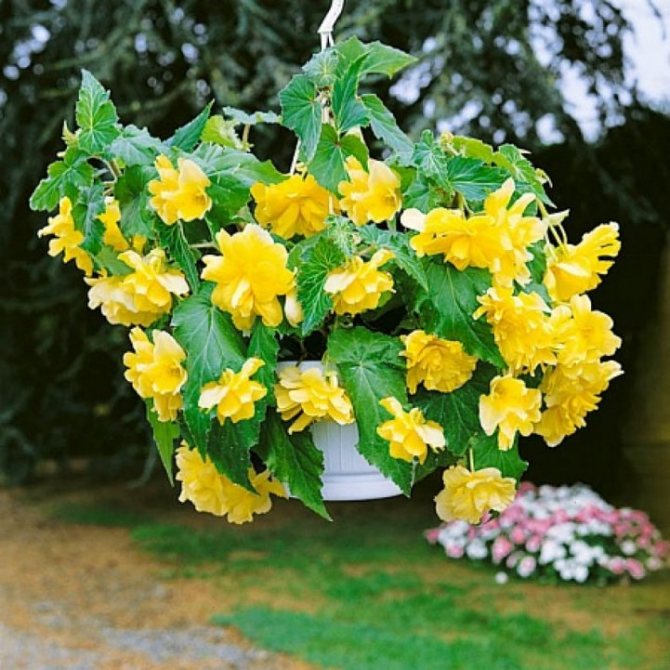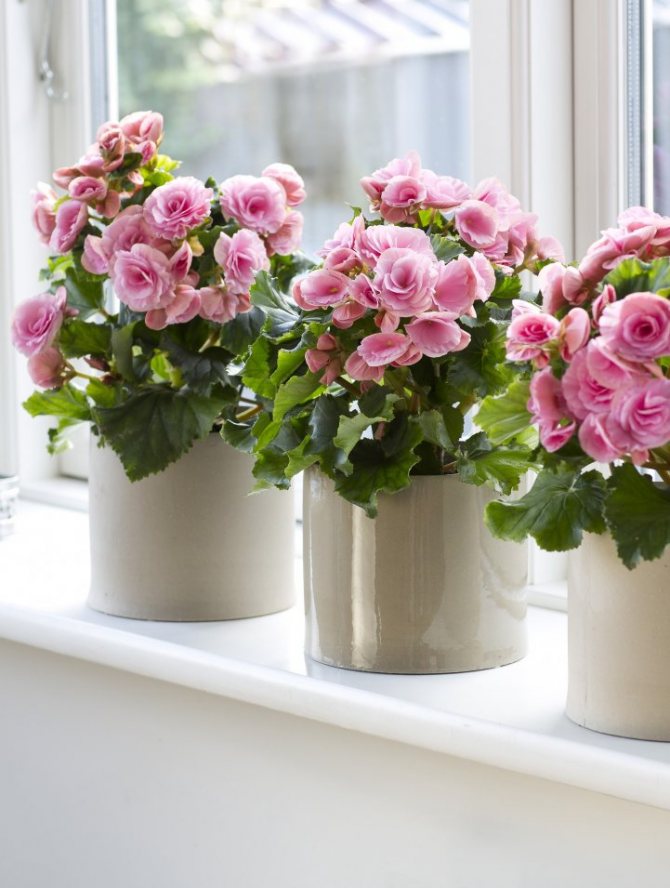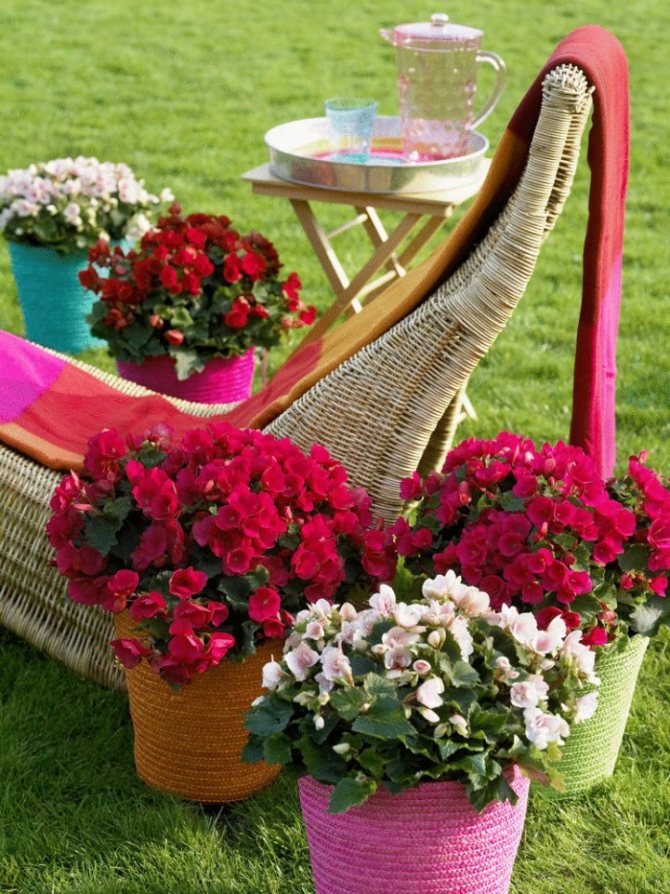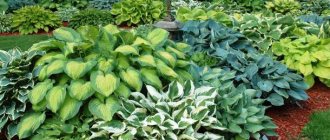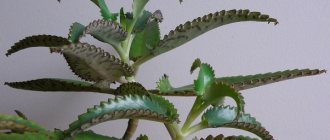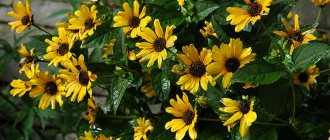At first, I grew this flower exclusively in a balcony box (the ever-flowering begonia was advised in a flower shop when I complained that petunias were bored and I was looking for something new, unpretentious, outdoor).
Having figured out that the flower is really not capricious (although it looks very fragile), I multiplied my several bushes with the help of tubers and cuttings, and I planted a whole flower bed in the country. It was a great idea!

Planting begonias
On the street is grown tuberous begonia, she annual begoniathat can be grown from seeds and tubers.
When to plant
The best time to plant delicate plants in the garden is Junewhen warm weather sets in without the threat of a severe cold snap. Please note that begonia does not tolerate even the shortest frosts at all and dies immediately.
Sowing seeds
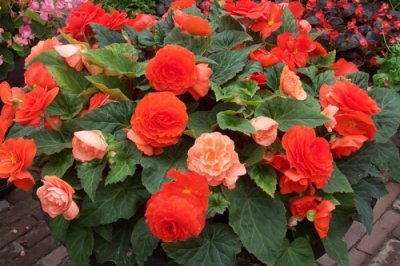

To get a flowering plant in summer, seeds for seedlings sown in February... You will need a container, preferably a wooden box, which is filled with a loose, lightweight substrate. It is made from river sand, garden soil and high-moor peat, mixing equal parts of the components.
Seeds evenly space in already moistened soil and lightly tamped without falling asleep on top of the earth. Finished plantings must be covered with thin glass or polyethylene film to create a greenhouse effect. Watering must be done very carefully so as not to erode the soil and not drown the smallest seeds, it is best to use a finely dispersed spray.
Sprouts appear later 6-8 days, after which the greenhouse is removed. The grown seedlings are subsequently thinned out or dived, keeping a distance of 1.5-2.5 cm between them.
Seat selection
Begonia loves light that provokes more lush bloom... Therefore, seedlings are planted in well-lit areas with shading at midday. Such a place would be just perfect for a tropical guest.
Soil preparation
The demanding beauty cannot grow in alkaline, dense and heavy soil.
A slightly acidic soil with good air permeability and rich composition is what begonias really need. When planting in garden soil, organic and mineral fertilizers, peat and compost are added so that the plant quickly adapts and takes root in a new place.
Planting process
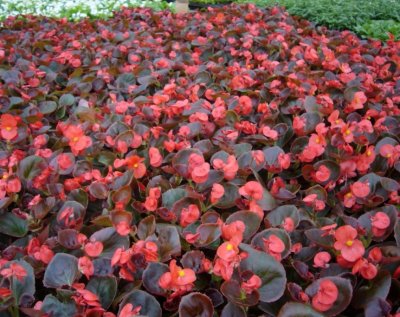

For each seedling is dug up separate hole, the distance depends on the size of begonias: dwarf varieties are placed according to the scheme 9-13 × 15 cm, and tall ones - 35 × 45 cm. Planting is done very carefully.so as not to break the fragile stem. For the same reason, it is important to bury the base of the shoot in the soil.
After planting, the soil surface is covered with humus or wood ash. At first, you can cover the seedlings at night, so as not to freeze them and give time to take root.
Groups
Begonia is a perennial or annual herb. It grows in a variety of ways: in the form of creeping grasses, tall bushes, dwarf shrubs. So that experienced gardeners and, moreover, beginners do not get confused, all types of begonias are divided into three conditional groups, each of which has its own distinctive features.
Tuberous
They are distinguished by large double flowers that bloom profusely on the bush. Also, this group of begonias has the longest flowering period.Tuberous plants can be grown in tubs or flowerbeds, or at home. Bulbs of this group overwinter in an old pot or in the refrigerator, and after waking up, they quickly resume vegetation.
Bush
They can be both annual and perennial. The former are more often used for street and tub cultivation. At zero temperature, the surface of the bush dies off, but it can resume its growth if the ground is not frozen and the roots are preserved.
Decorative deciduous
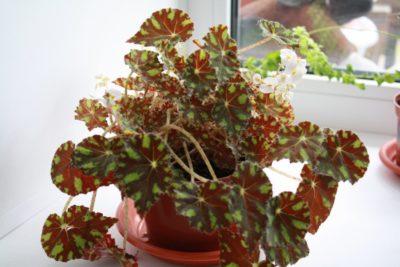

Bright, carved leaves distinguish this group from the rest. The most popular varieties with dull, "fluffy" leaves. They also reproduce such begonias - by rooting or by dividing the leaf.
But, despite the division, all begonias have several common features: the obligatory presence of unisexual flowers, a fleshy stem, asymmetric leaves, a powerful, thick rhizome.
Both gardeners and hobbyists sometimes confuse annuals and perennials. To avoid confusion, you need to consider in more detail the types of begonias.
Care and cultivation
Such a delicate beauty needs constant care so that she pleases with many inflorescences.
Watering
Only in the evening or in the morning and with exceptionally warm water under the spine. Otherwise, it is easy to destroy the root system and leaf blades. The interval between watering depends on the weather, on average, is from 3 to 5 days, in arid heat they are watered more often, avoiding severe dryness of the soil.
After the procedure, be sure to loosen the top layer so as not to get stagnant water that is fatal for begonia.
Air humidity
With sufficient watering, the southerner perfectly tolerates even the driest periods. Spray it on top strongly discouraged! Water droplets falling on flowers and leaves cause the appearance of ugly brown and chestnut spots.
Top dressing
An actively growing and long-blooming beauty very well consumes nutrients and needs a constant supply of new ones. You need her "Feed" every 12-15 days a mixture of trace elements, which must include phosphorus and potassium. You can use a ready-made fertilizer for flowering plants or directly for begonias.
You can learn more about the rules for caring for begonia here.
Street begonia care
- Choosing a site for a flower bed or a street flowerpot. Plant outdoor begonias in a bright area, but so that the direct rays of the sun do not touch the plant. If brown spots are visible on the leaves, this may indicate sunburn.
- Watering. It needs a regular, but moderate flower. It is desirable that the water is not hard. If you know you have one, you can soften it with vinegar (1 tablespoon in 10 liters of water). You can also sometimes water young begonias with mineral water (slightly acidic).
- Mulch. It will protect the soil from the rapid loss of moisture, and you - from the need to often weed out and plow the area. It is good to mulch begonia with sawdust, peat or expanded clay.


Fertilization and feeding
They are mandatory for street begonia, because it constantly blooms, which means it must draw strength from somewhere.
- Spring. The plant grows shoots and leaves. Buy a complex mineral fertilizer for begonia.
- Summer, budding. It's time for potassium-phosphorus fertilizing.
Top dressing is applied approximately once every 2 weeks.
Reproduction
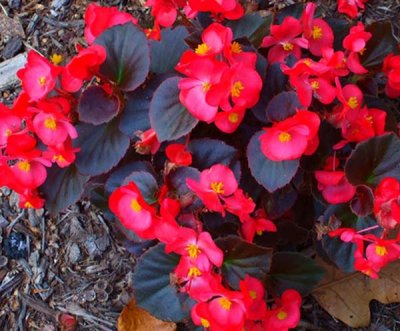

Possibly tubers, cuttings and seeds.
The first method is the simplest and most affordable, it is enough to separate the daughter processes from a large tuber and plant them separately. Cuttings need to be rooted in a loose substrateby placing them in a greenhouse. This can be done at any time, even in winter. Seed propagation is the most laborious method, but it produces a large number of new plants.
You will find more information on breeding methods for begonias in this article.
Annual or not?
Annuals include decorative and tuberous plants. After they have faded, the tubers are thrown away. All types of begonias do not tolerate the cold, therefore, perennial plants are dug up and transferred to the house for the winter. The tubers are sent for wintering in a cool place. Evergreen species have a poorly expressed rest period.
ATTENTION! In fact, there are no annual begonias, they are just often grown for the sake of flowering, like annuals.
Perennial garden begonia is a tuberous plant and is rather finicky compared to other species. She, like all other groups, does not tolerate direct sunlight, therefore it is recommended to plant it in shady places.
The tubers are not hardy, so garden begonia should be planted in June. It differs from home only in that for the summer period these flowers are planted in flower beds or displayed in flowerpots on the street.
The most popular are the following types:
- Eternal blooming.
- Ampelnaya.
- Tuberous.
- Graceful.
Eternal blooming
A small plant up to twenty centimeters in height, has thick stems and small flowers of red, pink and orange. Blooms all summer, regardless of weather conditions.
The most famous varieties:
- Baby Wing (has green or bronze leaves).
- Ambassador (the leaves have an unusual red border).
- Cocktail (brick-colored leaves).
We watch a video about growing ever-flowering begonia:
Ampelnaya
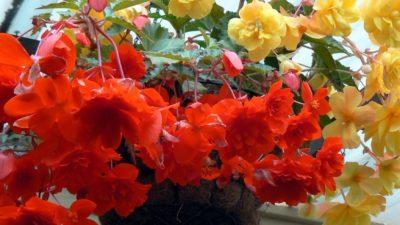

This species blooms from early spring to late autumn.
Descending stems up to 35 cm long have bright, green leaves and a huge variety of male and female flowers up to eight centimeters in diameter.
Each of them blooms for ten days. Plants of this species love diffused light and moderate air temperatures. (18-20 degrees).
Tuberous
Differs in tuberous rhizome and rich flowering. The flowers can be red, pink or white, different shades and two-tone options are also possible.
Graceful
They reach heights of up to 20 cm and have glossy, pale pink or white flowers. This plant is also called the Viennese begonia. It requires the timely removal of withered flowers and leaves.
Despite the fact that the species is called annual, the life of the plant can be extended to several years. The optimal months for planting such begonias are from late January to March. Such terms are due to the long growing season, and the best shoots are produced by pelleted seeds (which are in a shell of nutrients).
It is also possible to revive old tubers. During wintering, they are placed in a cool place, and with the onset of warmth they are planted, deepening in the soil by half, and watered once every three days. With the appearance of shoots, the tubers are covered with earth and placed in a place with good lighting.
IMPORTANT! If the perennial begonia lived only a year and did not sprout in the spring, then the storage conditions were violated (low temperature, for example).
Also, perennials can stop growing due to wear and tear on the tuber. In order for the plant to develop and grow well, its tubers must be divided - this stimulates it to grow actively.
Preparation for wintering
Naturally, begonia is an evergreen perennial that can bloom without interruption, even in winter. With us, this is impossible due to the onset of frost, but the begonia can be saved for subsequent planting in the spring.
When the air temperature starts fall below 15 °, the southerner stops blooming. Inflorescences and leaves dry up and fall off. At this time, from about mid-September to mid-October, all shoots are cut off, leaving a small stump. And the nodules are pulled out of the ground and prepared for wintering.
They can be rinsed in warm water or simply dried and then shaken off the dirt. Dried nodules are placed in a cardboard box or wooden box filled with sand, and sent to a cool place with a temperature of 3 to 7 °.
For germination, it is enough to rearrange the box with tubers in a warm room and moisten it in a timely manner.
Overwintering street begonia in a pot


The flower can bloom at homeif you dig it out of open soil before a cold snap comes. Caring for the garden begonia for the winter does not require much effort. At the end of August, the bushes you like are carefully transferred into pots along with the ground, having previously laid a drainage layer of stones on the bottom. Plants are brought into the house and displayed on the windowsill of the east or west window. Here the beauty from the tropics will receive enough light and warmth.
Description
The growing area of these plants is geographically located in the African, Asian, North and South American subtropics and tropics.
As a rule, for garden landscape design, 3 types of begonias are most often used, which are further broken down into a large number of varieties:
- tuberous - the height of the bush is about 3 cm, the flowers are large, reach a diameter of 20 cm, multi-colored. Female and male flowers can develop on the same plant. This species forms a fleshy tuber. The plant blooms from early summer to late autumn;
- ampelous - plant shoots are long and bushy, flowers of various shades;
- ever-flowering - this species is represented by a huge assortment. The leaf apparatus is small, oval, greenish or brownish in color. Often planted in squares and parks.
By height, these plants are divided into:
- high (25-35 cm). The most popular varieties: Volumia, Lotto, Baby Wing;
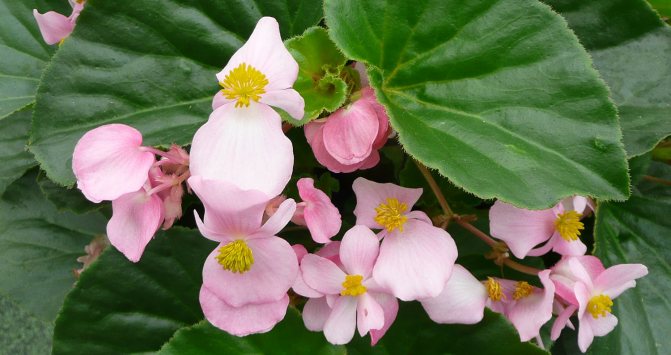

Garden begonia Baby Wing
- medium (22-24 cm). Sorts: Ambassador, Bada Boom, Bada Bing;


Garden begonia Ambassador
- dwarf (9-21 cm). Varieties: Cocktail, Queen, Luchik.


Garden begonia Cocktail
The plant has phytoncidal properties, cleans the air from pathogenic microorganisms. You can often hear the saying: "Begonia in the house - to the joy of the owners." When a plant develops well and blooms, harmony and prosperity reign in the house.
Diseases and pests
Garden begonia can be attacked by disease-causing fungi and harmful insects.
Powdery mildew
A fungal infection covers all terrestrial parts of plants with a white, flour-like coating. It is easily erased, but soon reappears. Begonia stops growing, the affected parts gradually fall off as they dry out. Sulfur preparations and fungicidal agents Fundazol, Rovral, Morestan, Hom will help to get rid of the misfortune.
Gray rot
Fungal disease develops in warm rainy weather. Watery blots with a gray coating appear on the affected plants, they quickly turn into rotting brown wounds. Shoots break, leaves curl and darken, buds and inflorescences become slimy to the touch. For treatment, fungicides containing copper are used, or innovative agents such as Skor, Ordan, Previkura.
Aphid
Small pest that feeds on juices. Forms entire colonies capable of destroying begonia plantings. It settles on the inside of the leaves. It is easily destroyed by insecticides - Aktara, Fitoverm, Decis and Aktellik.
Begonia is a very attractive and vibrant plant that not everyone can grow on their own. It takes a lot of time and effort to care for it.
Use in landscape design
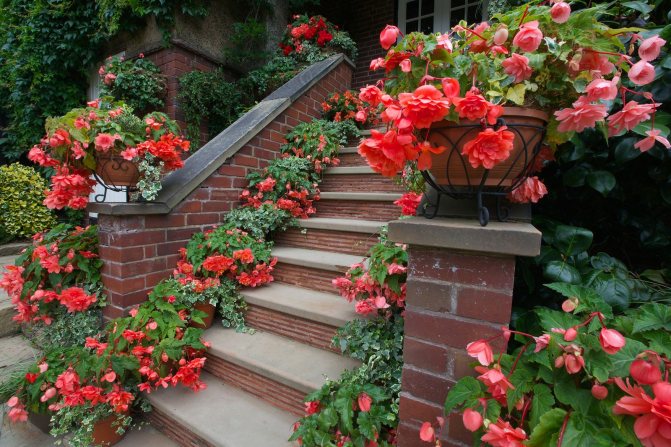

In different countries, landscape architects are actively using garden begonia to design various compositions. Before the arrival of frost, flowerpots with growing begonias look good in the frame of flower beds and on lawns. The plant pleases with bright colors even when many flowers have already wilted.
Due to its unpretentious and long-lasting flowering, garden begonia is ideal for growing in the garden, park or at home. That is why its selection and cultivation is carried out on an industrial scale.
Photo
Next, you can see a photo of planting and caring for Garden Begonia:
Perennial
In another way, she is called the ever-flowering beauty. Long-lived begonia pleases the eye with an abundance of beautiful flowers all summer long... If you live in an honest sector where there is a possibility of planting flowers, it will not be so difficult to care for begonias. With proper care, your work will be rewarded with beautiful flower buds that bloom one after another throughout the summer.
Compared to the blooming begonia for only one year, the garden perennial is a finicky tuberous plant:
- does not tolerate direct sunlight;
- prefers shady places for planting;
- tubers are not frost-resistant;
- it is recommended to plant in June.
Outwardly, it can be distinguished by its large, thick stem and delicate, smooth leaves.
Combination with other plants
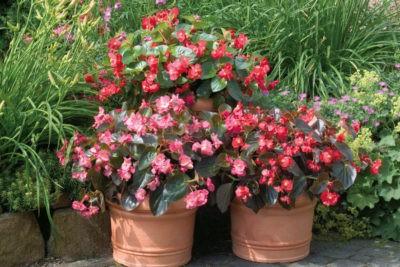

Street begonia works well for flower arrangements... It easily combines with various shrubs that give it partial shade, as well as decorative deciduous plants, perfectly complements low-growing perennial flowers.
Begonias look great with such border summer plants: surfiniya, lobularia, iberis, lobelia. An excellent tandem is obtained by merging begonias with asters, lilies, cenirarias.
Flower for the quartermaster
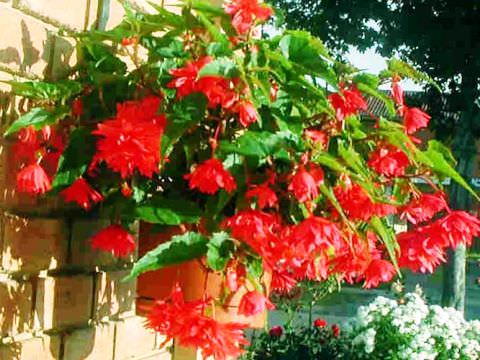

Mankind owes the discovery and detailed description of several types of begonias to the Franciscan monk Charles Plumiere and the French quartermaster of the fleet Michel Begon. The first of them was a botanist, as they were then called "the hunter of plants", and the second - simply dreamed of decorating the subordinate Rochefort with unusual specimens of plants.
It was quartermaster Begon who organized the expedition, during which Plumiere discovered in Haiti an unusual plant with asymmetrical leaves and pale pink flowers resembling butterflies. He named it begonia after his patron, and later discovered several more related plants. Unfortunately, during his return to France, Plumiere lost his herbarium and seeds due to the storm, only sketches remained. Michel Begon never saw the flower, thanks to which the memory of him remained in history.
Possible problems
Any florist knows that regardless of the variety, a flower needs an eye and an eye, otherwise you will not be in trouble. The main reason for this is the improper conditions of the plant.
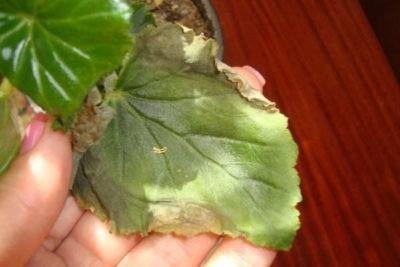

The tips dry first, and then the whole sheet - begonias do not have enough moisture in the soil and in the air. It is worth establishing regular watering and humidifying the room.- Pale color, shoots reaching for the light indicate a lack of sunlight.
- If the foliage curls and darkens, which means that begonias are lacking in nutrients.
- Decay of the root system, stem, leaves speaks of an excess of moisture, which leads to the development of a fungal disease, gray rot. To combat this phenomenon, special solutions of fungicides are used, as well as 1% Bordeaux liquid.
- Bacterial spot - this disease is dangerous for begonias. The plant becomes covered with watery spots, which soon turn brown, and the inflorescences and shoots become black. To treat this ailment, the soil is treated with disinfectants.
- High humidity and complete lack of ventilation cause the development of powdery mildew, which is characterized by a white bloom on begonia leaves. If measures are not taken in time, the plant, starting from the leaves, dries up. With a similar misfortune, they are also treated with the help of fungicides.
No less problems can be caused by pests such as aphids, spider mites.... They feed on the sap of the plant. Insects are located on the back of the leaf. You can remove them by treating the foliage with a soapy solution of tobacco or chamomile. Also an effective remedy to combat them is insecticide preparations. Carry out procedures for the elimination of harmful insects until they disappear completely.
Ornamental foliage begonias are charming plants. Only one thing is upsetting - they are not longevity. After several years, the plant loses its decorative properties. This means that the flower should be regularly rejuvenated, and not be afraid to multiply. And then, begonia will delight with its unsurpassed beauty.
If you find an error, please select a piece of text and press Ctrl + Enter.
Growing begonias from seeds
The begonia plant has very small seeds, so when planting they need to be mixed with a small amount of coarse sand. This technique allows you to get not very dense, but uniform seedlings. To obtain seedlings, seed is sown in January in greenhouses.
Before sowing, a soil mixture is harvested, which includes deciduous soil - 1 part, rotted humus - 2 parts, coarse river sand - 1 part.
Popular: Ophiopogon from the Liliaceae family to decorate your garden
When sowing, the seeds are sprayed over the surface of the moistened soil, but they are not sprinkled on top, but they are slapped lightly with the palm of your hand. Watering is done by spraying or sprinkling with water at room temperature. After planting, the site should be covered with plastic wrap.
The first zelents will appear in about two weeks. During this period, in the room where begonia seeds are germinated, it is necessary to maintain an air temperature of about + 20-22 C. For better development of seedlings, additional lighting must be installed. This will accelerate the development of young seedlings. The first inflorescences on a constantly blooming begonia can be seen after 17-20 weeks.


How to get seedlings: step by step instructions
At home, garden varieties of begonias are grown from tubers, which is why the plant was named "tuberous". The bulbs begin to be sown in early March, and in warm latitudes (Krasnodar Territory, Crimea), you can start breeding in February.
Tubers (bulbs): selection, planting, care
First of all, it is important for the grower to choose the right begonia tubers (they are also called bulbs). As a rule, the material is purchased in specialized stores, the assortment of which is quite large. Therefore, the main task is not to find tubers, but to select them correctly. Here are the first things to look out for:
- Of course, the bulb should have a normal appearance: no cracks, overgrowth, mold, etc.
- Dry bulbs are not allowed. Therefore, you should pay attention to their weight: healthy tubers are quite dense and heavy, while dry ones, on the contrary, are light.
- If you buy the bulbs in March, you can see how white or reddish buds are already starting to form on them. At the same time, it is optimal to buy material in January. There are still no buds at this time - the tuber is in a state of physiological rest.
By size, it is better to choose those tubers whose diameter is more than 3-4 cm.
Planting a tuberous begonia in a pot itself will not take much time. The main requirement is to create optimal lighting, watering and temperature conditions. The whole process can be conventionally divided into 3 stages.
Step 1. Preparation of tubers
It is useful to know not only how to plant a begonia bulb in a pot, but also how to prepare it for the ground. First, the tuber is completely cleaned of all rotten sprouts. If the bulb is large (6 cm or more), you can cut it in half and sprinkle the surface with charcoal.
Then the tuber is immersed in a solution of any fungicide (for example, "Maxim") and kept in it for half an hour. Instead of a fungicide, it is allowed to use a solution of potassium permanganate with a concentration of 1%. It is enough to hold for 40-45 minutes.
NOTE
All work with tubers should be done very carefully. Do not drop, bump or crush the bulbs.
Step 2. Planting tubers
The pot or box must be placed on a pallet - after all, abundant watering of future begonias is supposed. Drainage is laid at the bottom (expanded clay, pebbles), then the soil.The surface of the ground should be 3-4 cm below the edge. A small depression is made in the center, into which the tuber is planted.
Each bulb has 2 sides - convex and concave. It is only necessary to place it in the ground with the convex side (accordingly, the concave side will look up). It is important to consider that the top third will remain on the surface. When the first shoots appear, they can be lightly sprinkled with earth.
Step 3. Care of the sprouts
Now it remains to thoroughly water the soil - it should become noticeably wet (but not too much). Place boxes or pots in a sunny spot. However, direct rays should also be avoided. To solve this problem, you can use the following tips:
- Optimally arrange containers in the west or east.
- If the sun's rays are too much, you can create partial shade using a curtain or shade from other plants.
- Well, in the case of south windows it is better to put the container a little further from the windowsill.
- Concerning temperature, then it should be at least 20-22оС. Indeed, in order to understand how to properly plant tuberous begonia in a pot and care for it, it is important to consider that this plant came to us from the tropics. Therefore, at home, they provide a sufficient level of humidity and illumination.
- Watering mode determined by the condition of the soil - it should always be moderately moist. At the same time, water is not allowed to enter the tuber itself - it can rot and die.
Normally, the first shoots will appear in 5-7 days, and after another 15-20 days 2-3 leaves will flaunt on the tuber. A month will pass, and with proper care, the first flowers will appear on the tuberous begonias, which will mark the onset of spring.
NOTE
- If later it is planned to transplant a flower into open ground (for example, to decorate a garden or summer cottage), this can be done a month later after the emergence of the seedling.
- However, if you are not sure that there will be no more frosts, you can simply transplant the flower into a pot with a diameter of 25-30 cm and wait for the final onset of the warm season.
Seedling seeds
This method requires certain labor costs and in general it looks more troublesome. On the other hand, the gardener gains invaluable experience in plant cultivation. In addition, you can grow many begonias at once, from which you can create a beautiful flower garden in the garden or in the country.
The cultivation technology looks like this:
- The process starts already in January (before the beginning of February) - after all, by the spring you need to get ready-made seedlings and distribute them in pots. However, you can plant seeds later - they will bloom, but only in the fall.
- The seeds are usually immediately mixed with a little sand: they are quite small and can be blown away by the wind.
- Typically, seeds are grown in boxes. You can choose a container from any materials, while it should not be too deep (10-12 cm in height is enough).
- The soil is prepared in advance according to the scheme described above. You can also use peat tablets. Immediately before planting, the soil is watered abundantly - it should become noticeably moist.
- Then the seeds are spread over the surface. You should not fill them up - you can only distribute a handful of soil over the entire surface.
- Then you need to wait a few hours and cover the box with glass, and put paper on top. The temperature should be about 21-23 ° C.
- Seedlings appear after 2 weeks. At this time, the glass is removed, and the box is removed to a cooler place (18-19 ° C).
- After the appearance of 3-4 leaves, a pick is carried out. At the same time, the first mineral fertilizers are applied. It is important that nitrogen and potassium are present in them - otherwise begonia will grow much more slowly.
- Seedlings need constant watering. Before the first shoots appear, the soil can be moistened with a spray bottle. And when 1-2 leaves appear - water as usual.
Appearance and features
For the first time, decorative flowering begonia was seen in Berlin, in the botanical garden. She was brought there from Brazil in 1821. From this date, the cultivation of the plant began. Later, one after another, new hybrid varieties and species appeared. Considerable breeders in Denmark and France contributed to the "improvement" of begonia.
Many hybrids bred at that time are still in use today. For example, Philip's begonia with pink flowers is used to decorate borders, and tall types of begonias are used in urban landscaping. At the moment, science knows more than 600 varieties of flowering begonias. The ever-flowering plant is a complex hybrid. Numerous varieties were used in the production process.
The plant is a bush, 40 cm high. The leaves have an unusual glossy shine, their shades are different, ranging from rich green to burgundy, brown. The foliage is round, asymmetrical.
The flowers are small in diameter, but numerous. The color is white, yellow, orange, apricot, pink, scarlet, red. The shape resembles inflorescences of peonies, roses. The inflorescences have a double and simple texture.
Ever-flowering begonia in the garden
Seedlings are planted in June. It is used by landscape designers in group plantings on flower beds, borders, rabatki. Low height and bushiness allow the begonias to be placed in the foreground. The soil should be neutral or slightly acidic, well-drained. Humus and peat are added to the sandy soil. Before planting, prepare holes 15 cm deep. They are well moistened. Seedlings are taken out of the pots along with a clod of earth, being careful not to damage the roots. The distance between begonias depends on the variety. Medium species are planted 12-15 cm apart, large - 20-25, small - 10 cm. In the first week, watering is performed regularly - in the morning or in the evening, when there are no scorching rays of the sun. The soil is periodically loosened and weeded.
Advice. Cut off individual shoots that are drawn in more strongly than others. This will form a beautiful bush.
In temperate latitudes, a thermophilic plant does not tolerate wintering outdoors. In the fall, it is dug up and placed in a flowerpot. Begonia is used for grafting or left to bloom on the windowsill.
Breeding
Hybrids of this variety with simple, smooth flowers are propagated by seed.... The seeds are quite small, so you can mix them with sand and sow them. The sowing process itself should begin at the end of February.
Seeds are sown in a container with pre-heated soil. After slightly moisten, covering with glass or transparent film. At a temperature of + 22-24 ° C, seedlings will appear in 2-3 weeks.
At first, they develop slowly, and over time, faster and faster. To speed up the development process, it is better to supplement the seedlings. Young shoots are planted in the ground at the end of the night frost, when it will be constantly warm. About 18-20 weeks after germination, the plant begins to bloom.
Another method for breeding begonias is cuttings. In early spring, before the onset of the growth phase, the begonias are cut off. Shoot roots are treated with drugs to stimulate root formation, which will accelerate the growth of roots. Then placed in water or soil substrate.
It is worth providing the cuttings with a greenhouse effect. They should be in a body room with a temperature of at least + 20 ° C. When the roots hatch, the plant can be transplanted into pots. More information about the reproduction of ever-flowering begonia and further care of the flower can be found here.
Subspecies
As a result of many years of selection and crossing of all kinds of classes of plants, as a result, a huge number of hybrids were obtained.
Below are the most common ones.
Tuberous species


There are double, semi-double and smooth flowers. The color is white, pale pink, yellow, scarlet, bright red. The stalk is fleshy, strong. This species is distinguished by a long flowering process.: from the first days of June to the end of November. When growing tuberous begonias outdoors, it is important to pay attention to certain nuances. In winter, the plant needs greenhouse storage.
Ampere


The length of the shoots hanging down is up to 80 cm. Cascading varieties of ampelous begonias look good when decorating outdoor vertical structures. They are grown in hanging flowerpots or on stands. Hybrid varieties remain attractive even with the onset of light frosts.
Eternally flowering
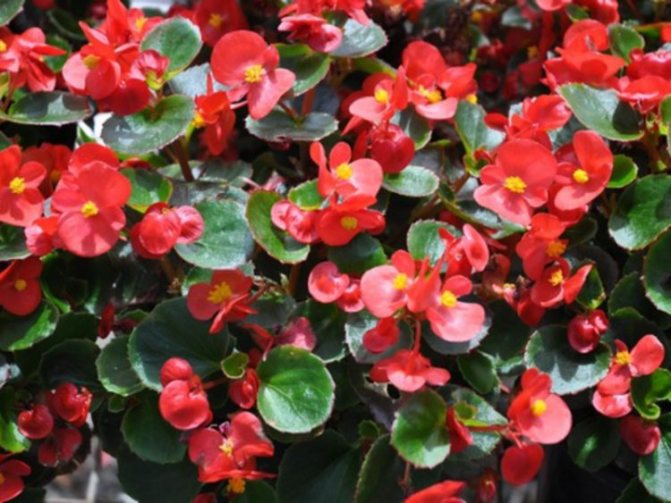

There are numerous varieties of this subspecies. The bushes grow small, up to 15-20 cm high. The foliage is oval in shape, smooth texture, color ranging from light green to brown. They are used for decorating flower beds in parks, squares. Plants are not capricious, even beginners can take care of them.
More details about begonias can be found here.
Gardening Secrets for Lush Bloom
In order for begonia to decorate a flower bed, to please with many buds, the plant needs to be regularly fed with complex fertilizer, to pick off dried leaves, to irrigate in time, but not to overflow, to prevent diseases, and protect from pests. It is necessary to ensure that the land under the exotic flower is not covered with buds or petals, as this is fraught with the development of rot.
Gardeners recommend watering a tropical guest not only with mineral and soft water, but also with infusions made from onion husks, garlic shoots.
Flowers begin to crumble with excess moisture and high temperature. In this case, you need to shade the begonia, reduce the frequency of irrigation. When optimal conditions are created, the buds do not fall off, and the plant is covered with white, pink and scarlet flower caps.
Varieties and types of begonias: photos
Where does begonia flower grow
In the wild, begonia grows in tropical rainforests and in the highlands. Most begonias are found in Argentina and Brazil, Venezuela and Bolivia, Peru and Chile, India, Pakistan, the Malay Islands, Sri Lanka and in the western part of the African continent.
Despite the favorable climatic conditions, the begonia flower does not grow in the vastness of Australia and the Polynesian islands. Indoors, these flowers can grow all over the world, the main thing is to create the necessary microclimate for begonias.
Can I plant outdoors?
Begonia is considered a moisture-loving plant. Prefers to grow in partial shade. However, it is now easy to find varieties that thrive in an environment with high temperatures and low humidity. They are not afraid of light frosts and torrential rains.
Most often, tuberous varieties are planted in open ground. Rhizome flowers are planted in flower beds in summer, and at the end of autumn they are transplanted into flowerpots and brought into the room. Sometimes, in order not to waste time, gardeners plant begonias in pots, they decorate flower beds and balconies.
In bad weather, they hide it back into the house. But for a plant, such transfers are unfavorable. Therefore, as practical experience shows, it is better to choose adapted varieties for our climatic conditions or find a suitable place right away.

